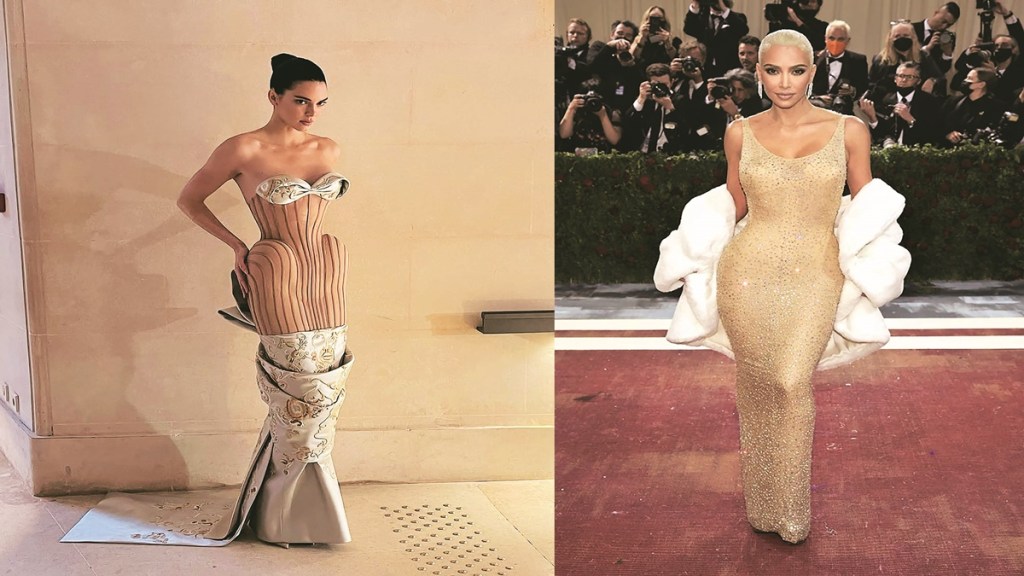Earlier this year, the Schiaparelli show in Paris was the talk of the town for experimenting with trompe l’oeil, a technique that avant-garde Italian fashion designer Elsa Schiaparelli had often incorporated into her designs to create a realistic illusion, making it appear that an object or detail is three-dimensional when it is actually flat.
With bigger shoulders, neoprene padding at the hips for exaggeration, embellished with draped pearl grey duchesse satin, and embroidered with flowers, the technique created a 3D effect on the models’ bodies—just to create an hourglass figure, a recurring theme on the ramp for ultra-thin, shrunk bodies.
Thin is in—again?
If you’re an avid follower of the fashion industry, you would have noticed a strong (and worrying) comeback of extreme thinness, with size-zero models strutting the ramp globally. As per data from the Vogue Business Autumn/ Winter 2025 size inclusivity report, of the 8,703 looks in 198 shows and presentations, 97.7% were straight-size (US 0-4), 2% were mid-size (US 6-12) and only 0.3% were plus-size (US 14+).
Plus-size and midsize models are also known as ‘curve models’. The autumn/winter figures were worse than the representation in the spring shows, which took place in September and October and included only 0.8% plus-size looks.
There’s no end to flaunting of flat stomachs, visible rib cages, and jutting collarbones on the ramps. Last year, Bella Hadid, who modelled for French designers Coperni, stood almost naked for nine minutes while a dress was sprayed on to her slim body, flashlighting hip bones.
The rising popularity of Ozempic and Wegovy for shrinking bodies among celebrities and influencers on the red carpet is another reason for the return of ultra-thin bodies. In 2022, American icon Kim Kardashian lost 16 pounds to fit into Marilyn Monroe’s dress for the Met Gala event.
As per Dr Soumitra Das, national head of sales and marketing at Kosmoderma, a premium skin and hair body clinic, the idea of a lean, sculpted body has always been a part of beauty standards, but in recent years, there’s been a noticeable shift back toward a preference for thinness—a trend amplified by digital media and social platforms.
“The resurgence of ultra-slim models and influencers has reignited conversations around body aesthetics, with people once again turning to non-invasive slimming treatments to achieve a more defined look,” adds Das.
India pushes back with inclusivity
However, back home in India, thinning has been a subject of discussion and criticism with many fashionistas advocating for diversity and inclusivity. “Runways should reflect the world we live in, not a curated fantasy. Inclusivity shouldn’t be a marketing gimmick, it should be a movement. And we’re committed to being part of that shift,” says Akanksha Khurana Jeet, founder of Purple Thoughts, a talent management company and production house.
“For fashion weeks, we have a different set of talent pools, and we don’t often find many takers for modelling. It is limited to metro cities. More or less, the same set of models participates, we never choose on the basis of how thin they are,” says Sunil Sethi, chairman of the Fashion Design Council of India (FDCI).
Sethi gives an example of FDCI fashion shows where inclusivity and body positivity are visible across the stage. “Not all global trends work in India and it is one of the few countries to promote inclusivity. This trend of thinness on ramps has not come to India. If we look at the FDCI India Couture week, it is all about bridal lehengas, and most designers choose style, design and aesthetics that are for all body types. So as a design fraternity, we do not conform to the trend. Slimmer look might be the case with cocktail gowns but not otherwise,” adds Sethi.
Homegrown fashion brands are also on a mission to cater to women across demographics. “In fashion, we have always used tall and slim-framed girls because they present clothes better on the ramp and for lookbooks. The movements do change—the 1950s was the hourglass look by DIOR, the 60s saw the twiggy straight look, the 70s were a continuation and the 80s were more about the broad shoulders. However, in recent times with conversations about inclusivity and diversity becoming very important, larger conversations, I don’t think we can go back to just thin frames,” says Harmeet Bajaj, founder of homegrown Indian label Bunka.
Bajaj, who has worked in the fashion industry for three decades, feels thin models are often preferred to showcase clothes professionally on runways and in presentation formats. However, in campaigns, there are different ages and body types. “They reflect the true wave of change we are going through as society. Campaigns from designer Tarun Tahiliani or Eka are good examples that reflect a strong ongoing cultural change towards embracing diversity across age and shapes,” adds Bajaj.
For fashion designer Bhawna Rao, the collection is the hero. Glamourising thinness purely for aesthetic validation is a different story—one that can lead to physical exhaustion and emotional toll. According to Rao, body positivity started as a powerful movement, but the current version of it sometimes feels detached from reality.
“We’ve gone from encouraging acceptance to ignoring effort. Health still demands consistency—in movement, nutrition, and mindset. Whether a thin or curvier model brings that story to life —that’s entirely based on the creative narrative. I don’t believe in casting models to tick a box or follow a performative trend. Today, we do see brands showcasing one or two XL models to appear inclusive. But true inclusivity isn’t just about showing range—it’s about designing for it,” adds Rao.
Talking about a design approach in style, aesthetics, trends and even cuts, internationally acclaimed fashion designer and educator Julian Roberts, who visited Pearl Academy campuses across India for a series of creative workshops this year, says, “If we consider the designer’s approach, it often revolves around drawing inspiration from the world around us—trends, personal perspectives, and the cultural zeitgeist—all of which shape the creative process. These influences find their way into the designs, which then translate onto the runway or into brand campaigns. In many ways, this is an inherent part of design.”
Roberts is best known as the inventor of an internationally recognised method of fashion pattern cutting design called ‘subtraction cutting’, which he has personally performed in over 40 countries internationally during a period of 26 years.







